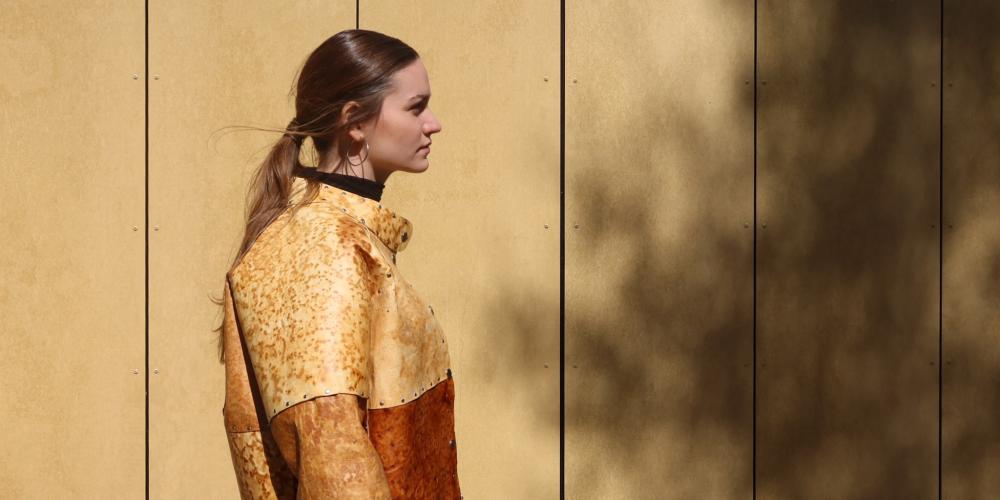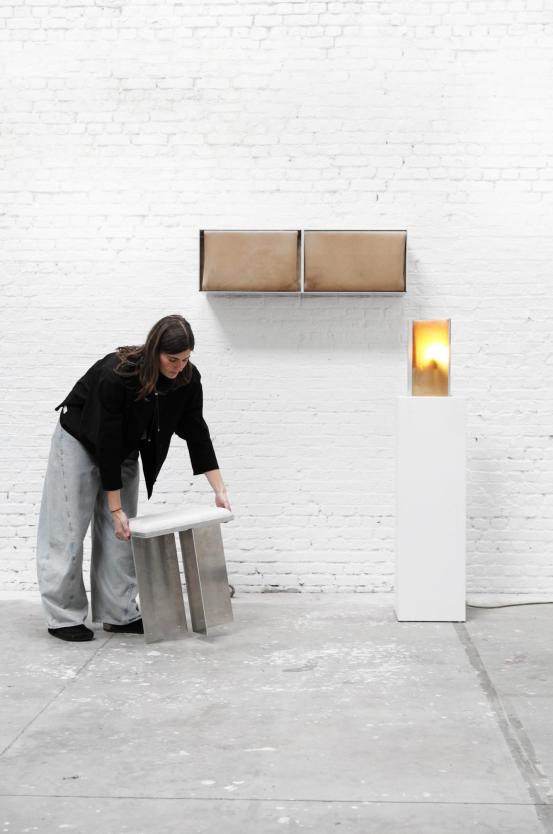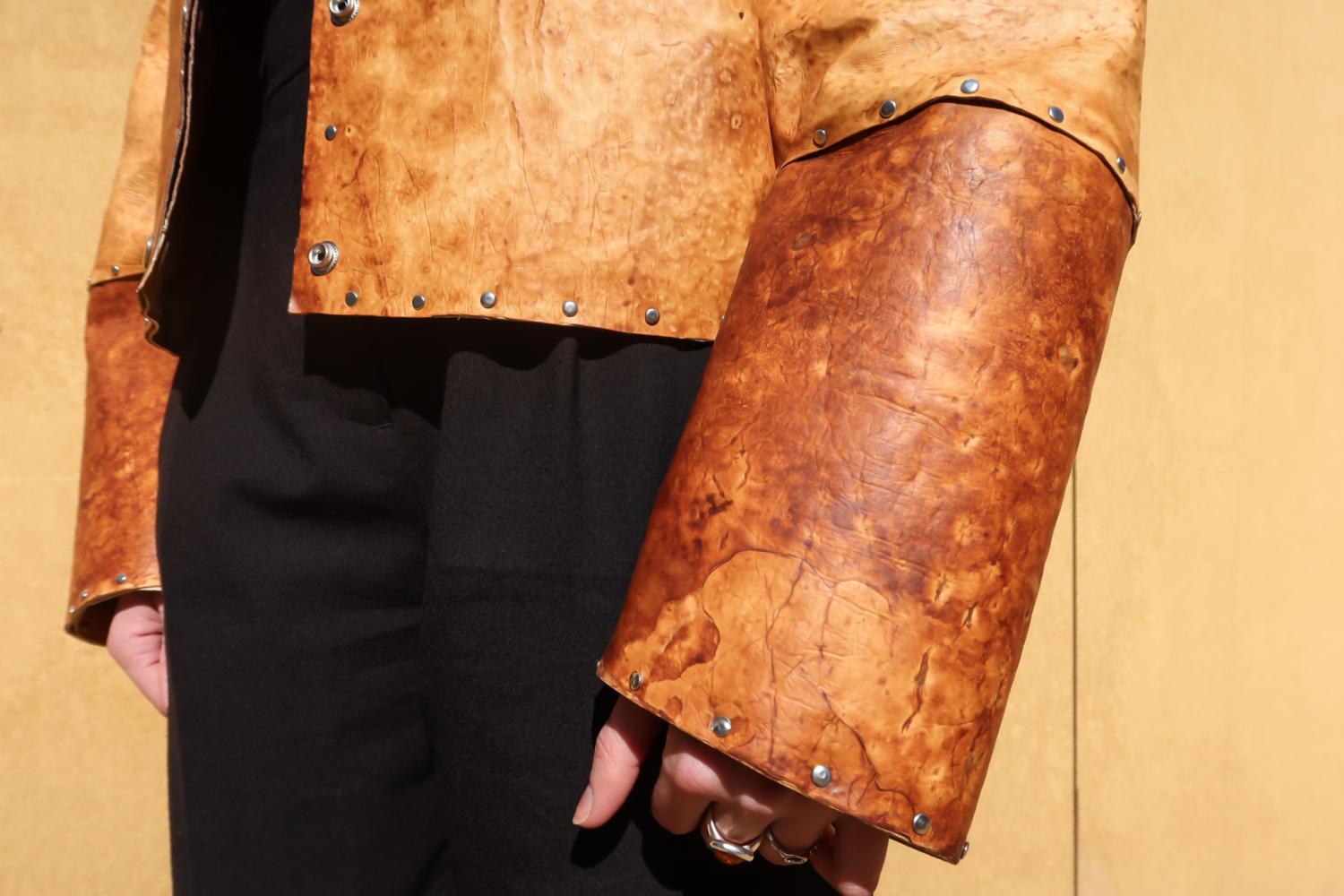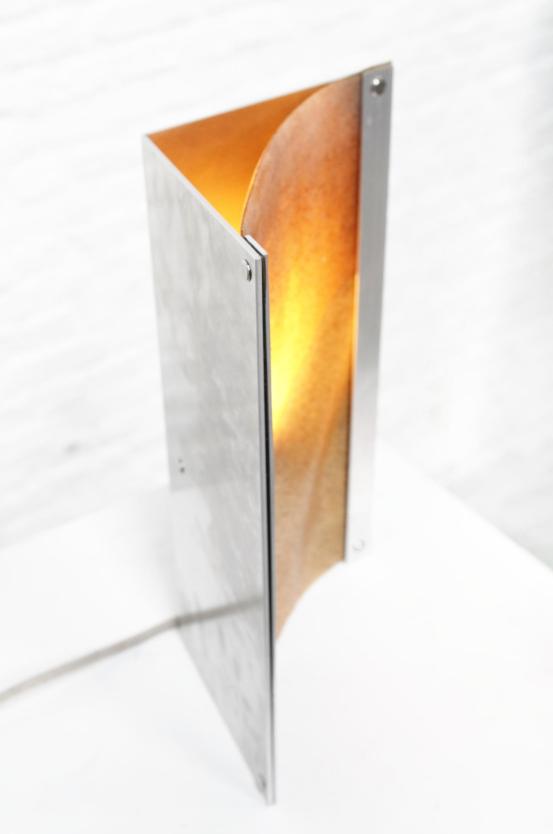
With a jacket and a furniture collection made from mycelium, PhD researchers Annah-Ololade Sangosanya and Anouk Verstuyft are heading to Milan Design Week – a testament to how research into the root structures of fungi can go hand in hand with design.
For the project Macro Fungal Skins, Annah-Ololade Sangosanya developed an entirely new jacket that demonstrates mycelium's potential as a textile for technically refined fashion. Anouk Verstuyft, meanwhile, focused on interior design with her furniture collection Fungal Functions. Her research shows that mycelium is not only functional and sustainable, but also has strong aesthetic appeal. Both researchers are part of the Microbiology research group, led by Professors Eveline Peeters and Elise Vanden Elsacker.
This week, you're showcasing two successful final products at Milan Design Week. How much research actually went into them beforehand?
Anouk: “Professor Elise Vanden Elsacker founded the mycelium team within the Microbiology research group in 2017. Elise has a background in architecture, which meant she adopted an interdisciplinary approach from the outset, bringing together bioengineers and designers. Annah-Ololade and I joined the team a year ago. Our research was specifically focused on developing the jacket and the furniture collection, but it built on years of earlier work.”
Annah-Ololade: “Take the material for the jacket, for example—there had already been a great deal of work done by Simon Vandelook. I learned the process from him and looked into how I could optimise the material specifically for a jacket.”
What is it that makes mycelium such a rewarding material to work with, in your view?
Annah-Ololade: “Where to begin?! Mycelium is incredibly versatile—you can use the fungal threads to create both composites and sheets of skin-like material that resemble leather. It’s also a sustainable material in its production and completely biodegradable.”
Anouk: “And don’t forget that mycelium is a living organism. That’s what initially fascinated me.”

Anouk Verstuyft presents her furniture designs.
"The general public still associates fungi with decay and death."
That sounds fascinating. So does that mean a jacket or piece of furniture like this is actually alive?
Anouk: “Not at the moment. The material undergoes a heat treatment at the end of the process to stop it from changing further. But keeping it alive opens up a lot of possibilities. Mycelium can grow on waste materials or even purify wastewater by absorbing toxic substances. So you're killing two birds with one stone—you're recycling or cleaning water as part of the process. The cushion of my chair, for instance, grew from agricultural waste.”
Annah-Ololade: “If mycelium leather were ever to remain ‘alive’, it might one day be able to repair itself. Imagine how incredible it would be if it could mend holes on its own. That’s something we’re currently exploring within the research group—how we might achieve that in a controlled way.”
Anouk: “Some people are put off by the word ‘living’, but just look around you. My table is made of wood, and that wood was once alive too. It only becomes inactive when it’s cut down. The same goes for real leather—it was once the living skin of a cow.”
“With mycelium, you can guide it, but ultimately it shapes itself. It’s not the human hand that determines its final form. That’s what fascinates artists and designers.”
Is the general public ready to bring a garment or interior item made of mould threads into their homes?
Annah-Ololade: "Indeed, the general public still associates fungi with rot and death. Many people forget how important fungi are to our ecosystem. We cannot live without them. With our collections, we hope to contribute to a positive image."
Anouk: "Studies show that people also struggle with the organic and heterogeneous appearance of the material. There are many irregularities in the texture and colour and we are not used to that. So in my research and in the design of the furniture, I also paid a lot of attention to improving the aesthetics."

Detail of Annah-Ololade Sangosanya's jacket.
Are other designers interested in working with mycelium?
Annah-Ololade: "I do feel there is interest. Among fashion designers today, there is a lot of focus on sustainability. Working with mycelium fits in perfectly with that. Mycelium also gives a new perspective on design. Design used to be about humans designing things and being in control. Mycelium can be given direction, but it is not man who finishes it, it forms itself. That intrigues a lot of artists and designers."
Anouk: "You also see it in our research group. We regularly get requests for collaborations with artists and designers. That often creates new ideas."
In an information brochure on mycelium a few years ago, you wrote that scientists and designers don't always speak the same language. What do you mean by that, Anouk?
Anouk: "I have a background in product development. At Erasmus at Aalto University in Finland, I came into contact with mycelium. Afterwards, I did a master's thesis on mycelium at Antwerp University. My first time in a lab came as a shock. As a designer, I was used to working very hands-on. I had no fear of getting dirty and experimenting with prototypes. Lab work is very precise and sterile. It was a challenge for me. And the reverse is often the case. But the years of interdisciplinary cooperation in this team mean that we know each other's strengths and know how to make good use of them. Moreover, Elise and Prof Eveline Peeters encourage us to develop both those sides in ourselves as well."
Annah-Ololade: "Anouk started as a product developer and made the move to microbiology. I did the opposite move. I got a degree in bioengineering from INSA in Toulouse and then did a postgraduate degree in “Textile and Technology” at Fabricademy Barcelona, IAAC university. Fashion was always a passion. As a little girl, I was already sewing clothes. That interdisciplinarity is definitely in us."

Lamp with cap made of mycelium.
"It's great that the design world is interested in what we are working on in our research group."
You not only developed the mycelium for the jacket and furniture, you also did the design. What impact did the research on mycelium have on design?
Annah-Ololade: "I experimented a lot with thicknesses and flexibility. Each mycelium skin I developed had different qualities. One was more flexible, the other more foamy. And that had an impact on how the skin absorbed the coating I applied. That led to colour differences. I played with those patches of skin, in different shades and different textures, in the final design."
Anouk: "My three designs each show a different quality of mycelium. I already talked about waste recycling and purifying wastewater, my cabinet in turn shows that mycelium also has self-colouring properties. This is interesting, textile dyeing is often something that is done afterwards and it is a process that requires a lot of water and often releases harmful substances. Here, the colouring happens simultaneously and is completely organic."
What does it mean to you to be at Milan Design Week?
Anouk: "For me, it really is a milestone. I have worked hard to find a good balance between science and design. That I now get to represent the research group at a design fair is a recognition of that interdisciplinarity. So I am very happy that we are getting this opportunity."
Annah-Ololade: "It is great that the design world is interested in what we are working on in our research group. I am ready to show how far we are with our research."
Anouk: "We will definitely also highlight the science side. In petri dishes, I will show how mycelium grows on waste, purifies wastewater and has self-colouring capabilities. And Annah will have a video with her showing how the skins of her jacket were created."
Annah-Ololade: ‘I am sure we will return inspired and with many new ideas.’